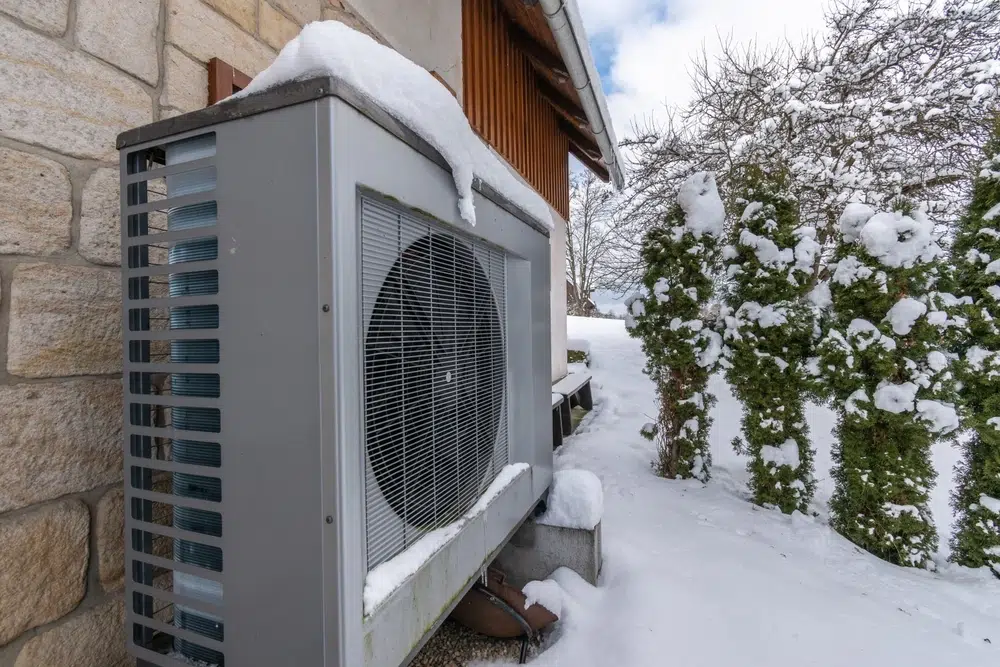Which is Best: Ducted Heat Pump or a Mini Split?
When it comes to heating and cooling your home, choosing the right system is crucial for comfort, efficiency, and long-term savings. Two popular options among homeowners are ducted heat pumps and mini splits (which are also heat pumps!). Both types of systems are heat pump system and offer unique benefits and are known for their energy efficiency, but which one is the best fit for your home? It depends on your home layout, budget, and a few other factors! In this article, we’ll explore the differences between these two systems, their ideal applications, and how to determine which is the right choice for you.

Understanding the Basics
What is a Heat Pump?
A heat pump is a versatile system that can provide both heating and cooling by transferring heat between the inside and outside of your home. It works similarly to an air conditioner during the summer by extracting heat from your home and releasing it outside. In the winter, the process is reversed, and the heat pump pulls warmth from the outside air (or ground) and transfers it indoors.
There are several types of heat pumps:
- Air-source heat pumps are the most common, extracting heat from the outside air.
- Ground-source (geothermal) heat pumps use the stable temperature of the ground to provide heating and cooling, offering higher efficiency.
- Water-source heat pumps transfer heat using water as the medium and are typically used in specific applications, like multi-family dwellings.
Heat pumps are often used for whole-home climate control and can be integrated into existing ductwork systems, making them an excellent option for homes that already have ducts in place.
What is a Mini Split?
A mini split, also known as a ductless mini split, is a type of ductless heat pump system that consists of an outdoor compressor and one or more indoor units, often wall or floor units. Unlike traditional central air systems, mini splits do not require ductwork, making them easier to install in homes without existing ducts.
Mini splits offer zoned heating and cooling, which means you can control the temperature in individual rooms or zones within your home. This flexibility makes them ideal for supplemental heating/cooling in specific areas, like a newly added room or a converted garage.
Key Differences Between Heat Pumps and Mini Splits
Installation
Ducted Heat Pump Installation:
Installing a heat pump typically involves integrating the system with your home’s existing ductwork. This can be more complex, especially if your home lacks ducts or if you opt for a ground-source system, which requires extensive excavation. However, for homes with existing ducts, a heat pump can provide a seamless whole-home solution.
Mini Split Installation:
Mini splits are ductless systems, meaning they are much easier to install. Each indoor unit is connected to the outdoor compressor via a small conduit, which requires only a small hole in the wall. This makes mini splits a great option for homes without ductwork or for adding heating and cooling to specific areas without disturbing the rest of the home.
Energy Efficiency
Ducted Heat Pump Efficiency:
Heat pumps are known for their energy efficiency, particularly Energy Star-rated models. However, their efficiency can vary based on climate. For example, air-source heat pumps may become less efficient in extremely cold climates, although advancements like dual-fuel systems and cold climate heat pumps have mitigated this issue. Importantly though, efficiency is highly reliant on good quality and properly designed ductwork – so make sure you are working with a licensed sheet metal shop who understands Manual D design.
Mini Split Efficiency:
Mini splits are highly efficient because they eliminate the energy losses associated with ductwork. With SEER (Seasonal Energy Efficiency Ratio) ratings often higher than traditional systems, mini splits can significantly reduce your energy bills, especially when used for zoned heating and cooling.
Cost
Heat Pump Costs:
The initial installation cost of a heat pump can be higher due to the need for ductwork and the potential complexity of the system, particularly for geothermal models. However, these systems offer lower operating costs and potential tax credits or rebates, making them a cost-effective choice over time.
Mini Split Costs:
Mini splits generally have lower initial costs, especially for single-zone systems. They are also scalable, allowing you to start with one or two zones and expand as needed. The absence of ductwork can reduce installation costs, making mini splits an affordable option for many homeowners.
Heating and Cooling Performance
Heat Pump Performance:
Ducted Heat pumps are effective for both heating and cooling, with cold climate heat pumps often work at full capacity to 5 degrees or less. A key factor to performance of ducted heat pump is the condition or quality of the ductwork as leakage can reduce efficiency.
Mini Split Performance:
Mini splits excel in providing targeted heating and cooling in specific areas. The use of inverter technology allows for precise temperature control, making them an excellent choice for zoned climate control. In larger homes, multiple units may be required to achieve full coverage.
Maintenance
Heat Pump Maintenance:
Maintaining a heat pump involves regular inspection and servicing of both the indoor and outdoor components. If your system includes ductwork, you’ll also need to schedule duct cleaning and inspections to ensure optimal performance.
Mini Split Maintenance:
Mini splits are easier to maintain, with fewer components than traditional systems. Regular tasks include cleaning filters and coils, which can typically be done by the homeowner. Professional servicing is less frequent, making maintenance simpler and more cost-effective.
Ideal Applications for Each System
Best Uses for Heat Pumps
- Whole-home climate control in regions with moderate climates.
- New construction or homes with existing ductwork.
- Environmentally conscious homeowners seeking high-efficiency solutions.
Best Uses for Mini Splits
- Homes without existing ductwork.
- Room additions or renovations where extending ductwork is impractical.
- Supplemental heating/cooling in specific areas of the home.
- Zoned temperature control for individualized comfort.
Pros and Cons at a Glance
Heat Pumps
Pros:
- High efficiency for whole-home systems.
- Dual-purpose heating and cooling.
- Potential for tax incentives.
Cons:
- Higher installation costs.
- Efficiency can vary in extreme temperatures (for air-source models).
- Requires ductwork (for most systems).
Mini Splits
Pros:
- No ductwork required.
- Highly efficient with less energy loss.
- Flexible, scalable installation.
Cons:
- Multiple units may be needed for larger homes.
- Higher upfront costs per unit compared to central systems.
- Indoor units are visible and may affect aesthetics.
Cost Comparison and Return on Investment
Initial Costs
- Heat Pumps: The cost of installing a heat pump can range from moderate to high, depending on whether you choose an air-source or ground-source system. Geothermal systems tend to be more expensive due to the excavation required.
- Mini Splits: Mini splits have lower upfront costs, particularly for single-zone installations. Each additional zone increases the cost, but it’s scalable, allowing you to spread out the investment over time.
Operating Costs
- Heat Pumps: Over time, heat pumps can save you money on energy bills, especially in moderate climates. Geothermal systems offer the lowest operating costs but require a significant initial investment.
- Mini Splits: Mini splits are highly efficient, leading to lower energy bills, especially when used for zoned heating and cooling. Their operating costs are typically lower than traditional systems, particularly in homes without existing ductwork.
Long-term Savings
- Heat Pumps: The combination of energy savings, maintenance costs, and potential tax incentives makes heat pumps a good long-term investment, particularly for whole-home applications.
- Mini Splits: Mini splits offer excellent long-term savings, particularly in homes where ductwork is impractical or where targeted heating/cooling is needed. The energy savings and reduced maintenance costs contribute to a favorable return on investment.
Environmental Impact
Heat Pumps
- Ducted heat pumps have a low carbon footprint compared to fossil fuel-based systems. Air-source heat pumps also reduce greenhouse gas emissions, and through inverter technology on cold climate heat pump systems they work well in Massachusetts through the winter often operating down to -13 degrees!
Mini Splits
- Mini splits, another form of heat pumps, also reduce energy consumption by allowing you to heat or cool only the spaces you use, rather than the entire home. This zoned approach minimizes waste and maximizes efficiency, contributing to a lower environmental impact.
Example: A Tale of Two Homes
Consider the following case studies to see how each system works in practice:
- Case 1: The Thompson Family – Choosing a Heat Pump The Thompsons live in a moderate climate and were looking for a whole-home solution to replace their aging HVAC system. They chose an air-source heat pump, integrating it with their existing ductwork. The result? Lower energy bills and a comfortable home all year round, with the added bonus of tax incentives that helped offset the initial cost.
- Case 2: The Martinez Family – Opting for a Mini Split The Martinez family added a new room above their garage, which wasn’t connected to their existing ductwork. A mini split was the perfect solution, offering them zoned cooling in the summer and supplemental heat in the winter without the need for costly ductwork extension. They appreciated the energy savings and the ability to control the room’s temperature independently.
Conclusion
Choosing between a heat pump and a mini split depends on your specific needs, home size, climate, and budget. Heat pumps are ideal for homeowners looking for a whole-home solution with potential long-term savings, especially if ductwork is already in place. Mini splits, on the other hand, offer unmatched flexibility and efficiency for homes without ducts or for targeted heating and cooling.
To determine which system is best for you, consider consulting with an HVAC professional who can assess your home’s requirements and provide personalized recommendations. Whether you opt for a heat pump or a mini split, both systems offer energy-efficient solutions that can enhance your home’s comfort and reduce your utility bills.
FAQs
- Can I use a mini split as my primary heating source?
Yes, mini splits can be used as the primary heating source, particularly in moderate climates or well-insulated homes. - How does a heat pump work in cold climates?
Modern heat pumps, particularly cold climate models, are designed to work efficiently even in lower temperatures. However, they may need supplemental heating in extreme cold. - Which system is more cost-effective in the long run?
This depends on your home’s specific needs. Generally, heat pumps offer better ROI for whole-home heating and cooling, while mini splits are more cost-effective for zoned applications. - Do mini splits increase home value?
Yes, mini splits can increase home value by providing energy-efficient, flexible heating and cooling options. - Is there any financial assistance for installing these systems?
Many states offer rebates, tax incentives, and financing options for installing energy-efficient systems like heat pumps and mini splits.





